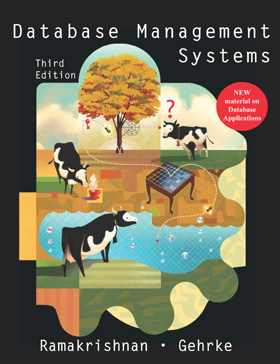 |
Database Management Systems |
![]()
|
|
WWW ResourcesLanguages Technologies Database Systems
C++ Info/Help
JSP (JavaServer Pages)"JavaServer Pages technology uses XML-like tags and scriptlets written in the Java programming language to encapsulate the logic that generates the content for the page. Additionally, the application logic can reside in server-based resources ... that the page accesses with these tags and scriptlets. Any and all formatting (HTML or XML) tags are passed directly back to the response page. By separating the page logic from its design and display and supporting a reusable component-based design, JSP technology makes it faster and easier than ever to build web-based applications." 1
Servlets"Servlets are pieces of JavaTM source code that add functionality to a web server in a manner similar to the way applets add functionality to a browser. Servlets are designed to support a request/response computing model that is commonly used in web servers. In a request/response model, a client sends a request message to a server and the server responds by sending back a reply message. From the Java Servlet Development Kit (JSDK), you use the Java Servlet API to create servlets for responding to requests from clients. These servlets can do many tasks, like process HTML forms with a custom servlet or manage middle-tier processing to connect to existing data sources behind a corporate firewall. In addition, servlets can maintain services, like database sessions, between requests to manage resources better than Common Gateway Interface (CGI) technologies." 2
"XML is a meta-markup language, a set of rules for creating semantic tags used to describe data. An XML element is made up of a start tag, an end tag, and data in between. The start and end tags describe the data within the tags, which is considered the value of the element." 3 "XML is a method for putting structured data in a text file. For "structured data" think of such things as spreadsheets, address books, configuration parameters, financial transactions, technical drawings, etc. Programs that produce such data often also store it on disk, for which they can use either a binary format or a text format. The latter allows you, if necessary, to look at the data without the program that produced it. XML is a set of rules, guidelines, conventions, whatever you want to call them, for designing text formats for such data, in a way that produces files that are easy to generate and read (by a computer), that are unambiguous, and that avoid common pitfalls, such as lack of extensibility, lack of support for internationalization/localization, and platform-dependency." 4
"XPath is the result of an effort to provide a common syntax and semantics for functionality shared between XSL Transformations and XPointer. The primary purpose of XPath is to address parts of an XML document. In support of this primary purpose, it also provides basic facilities for manipulation of strings, numbers and booleans. XPath uses a compact, non-XML syntax to facilitate use of XPath within URIs and XML attribute values. XPath operates on the abstract, logical structure of an XML document, rather than its surface syntax. XPath gets its name from its use of a path notation as in URLs for navigating through the hierarchical structure of an XML document". 5
"XSLT...is a language for transforming XML documents into other XML documents. A transformation expressed in XSLT describes rules for transforming a source tree into a result tree. The transformation is achieved by associating patterns with templates. A pattern is matched against elements in the source tree. A template is instantiated to create part of the result tree. The result tree is separate from the source tree. The structure of the result tree can be completely different from the structure of the source tree. In constructing the result tree, elements from the source tree can be filtered and reordered, and arbitrary structure can be added. A transformation expressed in XSLT is called a stylesheet. This is because, in the case when XSLT is transforming into the XSL formatting vocabulary, the transformation functions as a stylesheet." 6
"XQuery is designed to meet the requirements identified by the W3C XML Query Working Group [XML Query 1.0 Requirements]. It is designed to be a small, easily implementable language in which queries are concise and easily understood. It is also flexible enough to query a broad spectrum of XML information sources, including both databases and documents. The Query Working Group has identified a requirement for both a human-readable query syntax and an XML-based query syntax. XQuery is designed to meet the first of these requirements. For an alternative, XML-based syntax for the XQuery semantics, see [XQueryX 1.0] XQuery is derived from an XML query language called Quilt [Quilt], which in turn borrowed features from several other languages. From XPath [XPath 1.0] and XQL [XQL] it took a path expression syntax suitable for hierarchical documents. From XML-QL [XML-QL] it took the notion of binding variables and then using the bound variables to create new structures. From SQL [SQL] it took the idea of a series of clauses based on keywords that provide a pattern for restructuring data (the SELECT-FROM-WHERE pattern in SQL). From OQL [ODMG] it took the notion of a functional language composed of several different kinds of expressions that can be nested with full generality. Quilt was also influenced by other XML query languages such as Lorel [Lorel] and YATL [YATL]." 7
CookiesVisual Basic ScriptSoapDB2 SQL Reference
Inline References 1. http://java.sun.com/products/jsp/ 2. http://developer.java.sun.com/developer/onlineTraining/Servlets/Fundamentals/introduction.html 3. http://msdn.microsoft.com/library/default.asp?url=/library/en-us/xmlsdk30/htm/xmtuttut1authoringelements.asp 4. http://www.w3c.org/XML/1999/XML-in-10-points 6. http://www.w3.org/TR/xslt11/ 7. http://www.w3.org/TR/xquery/
|